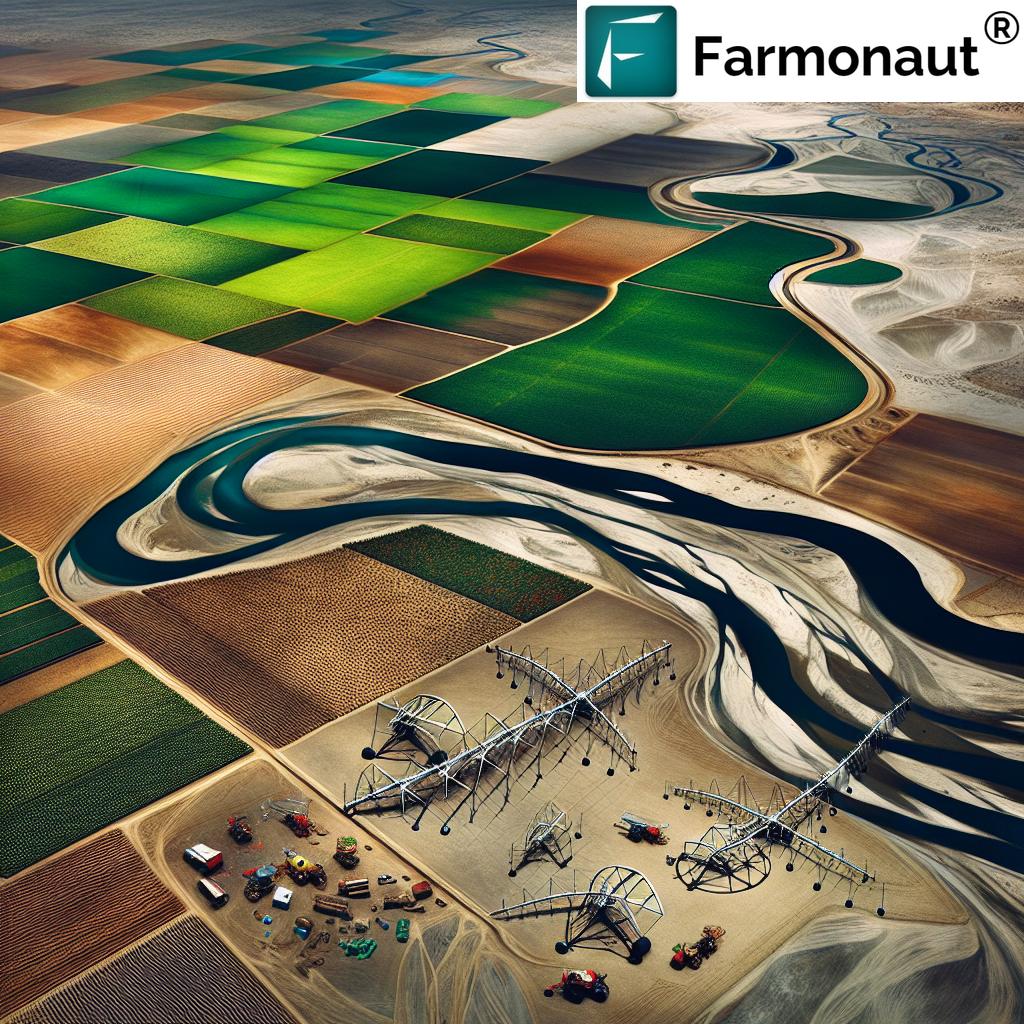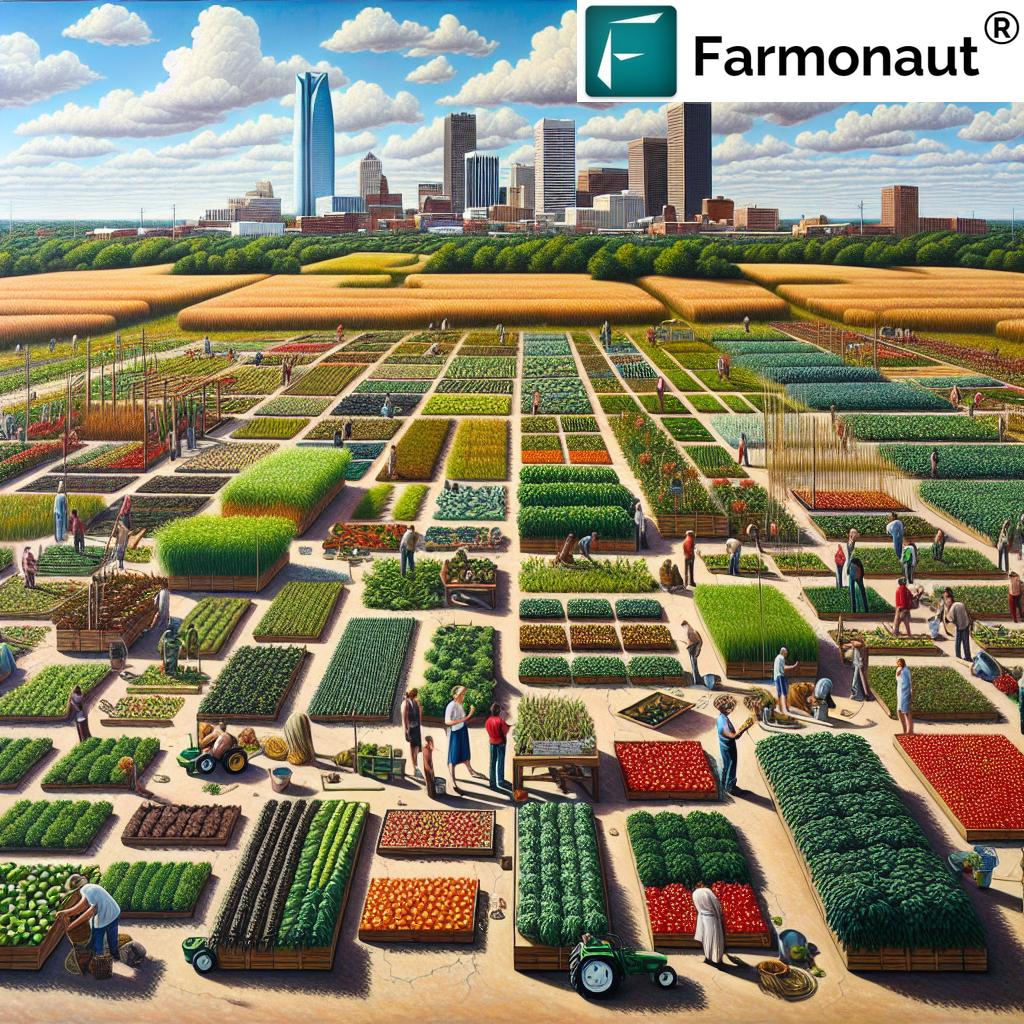Arizona Agriculture: 7 Solutions for Yuma’s Future
“Yuma produces over 90% of the U.S. leafy greens during winter, thanks to advanced water conservation techniques.”
Table of Contents
- Introduction: Arizona Agriculture at a Crossroads
- Arizona Agriculture Industry Trends & Current Challenges
- Overview: The 7 Key Solutions for Yuma’s Agricultural Future
- 1. Maximizing Water Conservation in Farming
- 2. Leveraging AI-Driven Agriculture Research Projects
- 3. Enhancing Soil Health Improvement Strategies
- 4. Collaborative University-Driven Agricultural Sustainability Initiatives
- 5. Advancing Intensive Farming Practices Responsibly
- 6. Fostering Workforce Health and Wellbeing
- 7. Mitigating Climate Challenges in Agriculture
- Comparison Table: Sustainable Farming Solutions and Their Expected Impacts
- Farmonaut: Technologies Driving Sustainable Growth in Yuma
- Farmonaut: Tools for Precision Agriculture
- Frequently Asked Questions (FAQ)
- Conclusion: Building a Resilient, Sustainable Future
Introduction: Arizona Agriculture at a Crossroads
Arizona’s vast, sun-drenched landscapes have long been the backbone of our nation’s produce. In particular, Yuma stands out as a cornerstone of the Arizona agriculture industry, especially in the winter months when it supplies over ninety percent of the United States’ leafy greens. Our region’s agricultural prosperity, however, is not immune to the growing pressure points of climate variability, dwindling water resources, evolving workforce needs, and the relentless march of technology.
Recently, a pivotal meeting brought local and state agriculture leaders, university experts, and policymakers together in Yuma. Represented were Arizona State University, Northern Arizona University, the University of Arizona, and the Arizona Department of Agriculture. Titled “Future of Arizona,” this unique forum—initiated by the Arizona Board of Regents—served as a think tank addressing urgent industry problems and identifying collaborative solutions.
We believe that the future of our agricultural heartland rests on our willingness to innovate, collaborate, and invest in sustainable farming solutions that blend tradition with cutting-edge artificial intelligence and research. In this comprehensive post, we explore the industry’s major trends, present the 7 most impactful solutions for Yuma’s future, and examine the transformative role of cross-university and digital collaboration.
Arizona Agriculture Industry Trends & Current Challenges
Our state’s farming landscape is shaped by dynamic trends and persistent challenges, each requiring advanced technology and collaboration.
- Water scarcity: Water is the most precious resource in Arizona’s arid climate, with the Yuma region relying on the Colorado River for irrigation. Fluctuations in rainfall, increased competition for water, and long-term droughts raise concerns over the sustainability of current practices.
- Climate unpredictability: Climate challenges in agriculture such as temperature extremes and unpredictable weather patterns threaten crop reliability and require adaptive strategies.
- Workforce and health: Ensuring the health, safety, and retention of employees is paramount as the industry faces evolving labor needs and increasing mechanization.
- Technological transformation: Investments in artificial intelligence in agriculture, satellite crop monitoring, and blockchain traceability are accelerating. Arizona’s universities have increased AI-driven agriculture research projects by 40% in the past five years.
- Sustainability: There is rising pressure for agricultural sustainability initiatives that balance productivity, environmental stewardship, and economic viability.
Our collective response must focus on deploying new solutions to address these interconnected issues while ensuring that Yuma’s agricultural output remains resilient for generations to come.
“Arizona universities have increased AI-driven agriculture research projects by 40% in the past five years.”
Overview: The 7 Key Solutions for Yuma’s Agricultural Future
After extensive discussions with local leaders, university researchers, and with direction from the Arizona Board of Regents, we have identified seven fundamental solutions that will define the path forward for Yuma’s agriculture:
- Maximizing Water Conservation in Farming
- Leveraging AI-Driven Agriculture Research Projects
- Enhancing Soil Health Improvement Strategies
- Collaborative University-Driven Agricultural Sustainability Initiatives
- Advancing Intensive Farming Practices Responsibly
- Fostering Workforce Health and Wellbeing
- Mitigating Climate Challenges in Agriculture
Let’s explore these solutions one by one, examining their relevance, expected impact, and the collaborative research and technology efforts involved.
1. Maximizing Water Conservation in Farming
In an arid region like Yuma, water conservation in farming isn’t just smart economics—it’s a necessity for long-term viability. Our future depends on deploying integrated water management strategies and digital monitoring to optimize every drop used in irrigation.
Why water conservation matters in Arizona agriculture industry
- Shrinking water allocations from the Colorado River threaten the lifeblood of the Yuma farming economy.
- Competition with growing urban centers and industrial demands puts further downward pressure on supply.
- Long-term drought conditions require adaptation, innovation, and partnerships with research universities.
Key approaches to conserve water include:
- Advanced drip and micro-irrigation systems that reduce evaporation and deliver water directly to the roots.
- Real-time soil moisture monitoring using digital farm management apps and satellite imagery to pinpoint when and where to irrigate.
- Efficient field designs and scheduling supported by AI-driven analytics, reducing overlap and runoff.
- Collaborating with university research teams to implement and assess experimental water-saving technologies.
With digital tools, Yuma growers can achieve significant water savings—sometimes up to 30–40%—while maintaining or even increasing crop yields. These real-world savings strengthen both farm profitability and long-term resource resilience.
For developers and agribusinesses seeking rich, near real-time data, Farmonaut’s satellite API allows seamless integration of weather, crop, and soil metrics into their systems. Developer docs make customizing these data streams simple.
2. Leveraging AI-Driven Agriculture Research Projects
The next wave of productivity and sustainability in the Arizona agriculture industry will be unlocked by artificial intelligence in agriculture and advanced data analytics, guided by collaborative university research projects.
How AI and machine learning redefine our approach
- Automated predictive analysis—Machine learning algorithms can forecast irrigation needs, pest outbreaks, or nutrient deficiencies, helping optimize both resource use and yields.
- Intelligent crop health monitoring—Satellite and drone-based technologies (like Farmonaut’s platform) identify crop stress days or even weeks before visible signs emerge, providing a powerful advantage to intensive farming operations.
- Blockchain-based traceability—Coupled with AI, blockchain ensures transparent supply chains. Learn more about this system for food safety and fraud prevention here.
According to the Arizona Board of Regents, all three universities are aggressively expanding their AI-driven agriculture research projects. By pooling expertise—rather than working in silos—our educators, scientists, and growers are pushing the envelope in everything from robotic harvesting to digital phenotyping.
AI has also empowered risk assessment for crop lending and insurance, ensuring more accurate and tamper-proof verification for financial institutions serving our farming communities.
3. Enhancing Soil Health Improvement Strategies
Soil holds the foundation of productivity, sustainability, and resource efficiency. In our arid landscape, soil health improvement is essential for resilient, high-quality harvests and streamlined fertilizer use.
Core tactics for soil health in Yuma:
- Digital soil monitoring—Using satellite imagery (such as NDVI) and field data via Farmonaut’s app, we can map soil moisture, organic matter, and compaction levels across every hectare.
- Cover cropping and crop rotation—These regenerative intensive farming practices boost soil biodiversity and protect against erosion.
- Precision amendment application—AI-driven advisories ensure nutrients are delivered where and when needed—minimizing runoff and ensuring only the required amount is used.
- Carbon footprinting—Track and optimize your sustainability metrics with carbon monitoring tools that help reduce inputs and environmental impacts.
University professors are working hand in hand with local growers and the Arizona Department of Agriculture to develop and test advanced soil health improvement protocols fit for our unique desert-to-river environment.
Such restorative strategies don’t just protect the land—they also deliver long-term cost savings, increased yields, and improved food safety for both markets and consumers.
4. Collaborative University-Driven Agricultural Sustainability Initiatives
Cross-institutional university collaboration in agriculture is proving to be one of our most powerful tools. By leveraging the strengths of Arizona State University, Northern Arizona University, and University of Arizona, we are combining knowledge in research, data analytics, public policy, and extension services.
Benefits of cross-university initiatives:
- Pooling diverse faculty knowledge and resource centers for multi-year agriculture research projects
- Rapid scaling and field-validation of pilot projects—from water conservation to blockchain traceability
- Securing state and grant funding through joint proposals under the Arizona Board of Regents’ Future of Arizona program
- Direct department-to-field feedback loops ensure solutions are evaluated and adapted in real time for actual on-farm impacts
As Senator Tim Dunn, representing Yuma, noted: “We’re not just talking about research from this professor at that university, but how we leverage the special abilities at each university, working together, collecting ideas, and moving forward collaboratively.”
These sustainability initiatives don’t just serve academic interests—they drive operational improvements, measurable environmental benefits, and resilience in the face of market or climate shocks.
Want to harness these academic breakthroughs for your own fields? Farmonaut’s large-scale farm management platform translates university research into actionable insights for digital transformation, regardless of farm size.
5. Advancing Intensive Farming Practices Responsibly
While the region has long practiced intensive farming practices, the future demands that these systems are both productive and sustainable. This means intelligently scaling techniques that maximize yield while preserving environmental and social resources.
What does responsible intensification look like?
- Precision input management—Satellite and sensor integration ensures that water, fertilizer, and pesticides are applied only where needed.
- Multi-cropping and rapid turnover—Advanced planning (aided by digital analytics) allows multiple harvests per year without sacrificing soil or water health.
- Digital fleet management—Farmonaut’s fleet management solutions optimize farming machinery movements, reducing fuel use, emissions, and costs across large plots.
- Continuous data feedback loops—Instant access to yield estimates, crop performance, and environmental stress ensures real-time course corrections.
By combining artificial intelligence in agriculture with ground-truthing from local leaders and researchers, every intensive practice can be refined to meet both economic targets and the region’s sustainability commitments.
6. Fostering Workforce Health and Wellbeing
The strength of Yuma’s agricultural output is inseparable from the health and safety of our workforce. As operations become more digitized and mechanized, fostering a healthy workplace culture is both a moral and business imperative.
Priorities in workforce health:
- Enhanced training—As AI and digital platforms grow, we must ensure our employees have the skills needed to benefit from (and not be replaced by) technology.
- Real-time safety monitoring—Wearables, digital attendance, and online communication systems help respond to health or injury events swiftly.
- Reducing exposure risks—Digital scheduling and smart field design can minimize sun, heat, and pesticide exposures.
- Mental health support—Collaborating with local agencies and universities, we are fostering employee wellbeing as a core metric of farm performance.
By prioritizing both technology adoption and employee health, we build a modern, resilient workforce grounded in respect, safety, and shared success.
7. Mitigating Climate Challenges in Agriculture
The future of Yuma farming is inextricably linked to our ability to proactively address climate challenges in agriculture. From droughts to heat waves, extreme weather directly affects both yield and operational continuity. Our response is a blend of data-driven risk management, sustainability investments, and adaptive experimentation.
How Yuma is responding to climate pressures:
- Real-time climate analytics—AI-powered forecasting tools deliver localized weather predictions, helping agriculture leaders make informed operational decisions on the fly.
- Diversifying cropping patterns—By exploring new crop varieties and rotations that withstand both heat and water restrictions, we reduce the risk of total crop loss.
- Carbon management—Using Farmonaut’s carbon footprinting technology, growers can measure, report, and optimize their greenhouse gas impact, aligning with both state and national sustainability mandates.
- Investment in shade and soil health infrastructure—Physical and biological methods are used to create microclimates and buffer crops from climatic extremes.
Our combined approach, built on partnerships between farmer feedback, university projects, and digital technology, ensures that every season can be met with greater confidence, resilience, and profitability.
Comparison Table: Sustainable Farming Solutions and Their Expected Impacts
| Solution Name | Description | Estimated Water Savings (%) | Potential Yield Increase (%) | Implementation Cost (Estimated Range) | University/AI Collaboration Involved |
|---|---|---|---|---|---|
| Water Conservation in Farming | Advanced irrigation, digital soil monitoring, precise scheduling | 25–40% | 5–20% | Moderate–High | Yes – All Arizona universities, AI platforms |
| AI-Driven Agriculture Research Projects | Satellites, drones, and AI for predictive insights and traceability | 10–20% | 10–30% | Variable (subscription-based) | Yes – Joint university projects, Farmonaut AI tools |
| Soil Health Improvement | Digital mapping, regenerative practices, carbon tracking | 10–20% | 15–25% | Low–Moderate | Yes – Research departments, digital platforms |
| University-Driven Sustainability Initiatives | Research-to-field pilots, sustainability research grants | 15–25% | 5–15% | Funded via grants | Yes – All three universities |
| Intensive Farming Practices | Precision inputs, multi-cropping, digital fleet management | 10–18% | 20–35% | Moderate–High | Yes – AI data integration |
| Workforce Health & Wellbeing | Digital safety, training, mental health support | N/A | 5–10% (indirectly) | Low–Moderate | Yes – Health research teams, digital apps |
| Climate Challenge Mitigation | Localized early warnings, carbon management, cropping diversity | Varies (5–20%) | Up to 15% | Variable (long-term ROI) | Yes – Academic, AI, and government teams |
Farmonaut: Technologies Driving Sustainable Growth in Yuma
To support Arizona agriculture industry and empower growers in Yuma, Farmonaut delivers a suite of data-driven, affordable technologies for all scales of operation.
Core features and value propositions:
- Satellite-Based Crop Health Monitoring – Real-time NDVI, soil moisture, and dynamic field maps from smartphones or browsers.
- Jeevn AI Advisory System – AI-driven, personalized crop and input advisories based on weather, soil, and field data.
- Blockchain-Based Traceability – Unmatched transparency and security for supply chains. Enhance brand trust and food safety.
- Fleet and Resource Management – Digital tools optimize vehicle, staff, and pesticide application, reducing cost and resource wastage. Learn more at Farmonaut Fleet Management.
- Carbon Footprinting – Track and lower environmental impact with live carbon measurement and reporting tools.
Accessible via Android, iOS, and web apps, Farmonaut’s platform brings precision agriculture within reach of every grower—from the largest Yuma export operation to the smallest regenerative farm. Its subscription-based pricing and scalable modules mean you pay only for what you need.
Farmonaut: Tools for Precision Agriculture
If you’re ready to take your farm management to the next level, try Farmonaut’s web platform or mobile apps today. Monitor your crops, optimize water and fertilizer inputs, manage fleets, and access research-driven advisories directly from your device.
For government bodies or agribusinesses interested in large-scale deployments, Farmonaut offers powerful tools for area and yield estimation, compliance, and remote monitoring.
API access is available for integration with existing digital solutions: Explore our API and developer docs here.
Whether you are an individual farmer, financial institution, or agency, Farmonaut delivers the insights and efficiency your operation needs to stay competitive and sustainable in Yuma and beyond.
Frequently Asked Questions (FAQ)
What is the future of Arizona’s agriculture industry?
The future of Arizona agriculture is built on integrating water conservation, climate adaptation, technology adoption—specifically through artificial intelligence and satellite monitoring—and leveraging interdisciplinary university research. Collaboration among public, private, and academic stakeholders is critical to achieving both economic and environmental sustainability.
How vital is water conservation in farming for Yuma?
Water conservation is foundational for Yuma’s agriculture, which supplies over 90% of U.S. leafy greens in winter. Innovative irrigation, digital field mapping, and AI-powered advisories—enabled by platforms like Farmonaut—are key to achieving sustainable water use, maintaining yields, and securing the region’s agricultural future.
How are Arizona universities involved in agriculture innovation?
Arizona State University, Northern Arizona University, and University of Arizona are intensifying efforts in AI-driven agriculture research projects. Through the Arizona Board of Regents’ “Future of Arizona” initiative, they align their capabilities to solve real-world farming problems—from climate readiness to health and traceability.
Can small and medium farms benefit from precision agriculture?
Absolutely. Affordable, subscription-based services like Farmonaut’s platform provide real-time crop health monitoring and actionable insights accessible through mobile devices—making advanced sustainable farming solutions available to all scales of operation.
How does Farmonaut help with traceability and compliance?
Through blockchain-based traceability features, Farmonaut allows growers and corporate clients to ensure every product’s journey from field to shelf is securely documented, increasing transparency, reducing fraud, and building consumer trust. Learn more about product traceability here.
How can agriculture businesses get started with these tools?
Download the Farmonaut app for Android or iOS, or use the web version—all offer easy onboarding tailored for Yuma and Arizona agriculture needs. Analytics, resource tracking, and carbon measurement tools help build both profitability and sustainability into your operation from day one.
Conclusion: Building a Resilient, Sustainable Future
As we look ahead, it is clear that the Arizona agriculture industry—with Yuma at its heart—can set a new benchmark for sustainable farming solutions globally. By aligning our local expertise with university-driven research, AI, and digital technologies, we ensure not only immediate profitability but also the resilience needed to address the challenges of a changing climate, variable water resources, and shifting workforce dynamics.
Let’s continue to invest, collaborate, and innovate—building a future where Yuma remains America’s winter salad bowl, known not only for its abundance but for the intelligent, sustainable methods that make it possible.
Ready to embrace agricultural sustainability and innovation? Get started with Farmonaut today.















